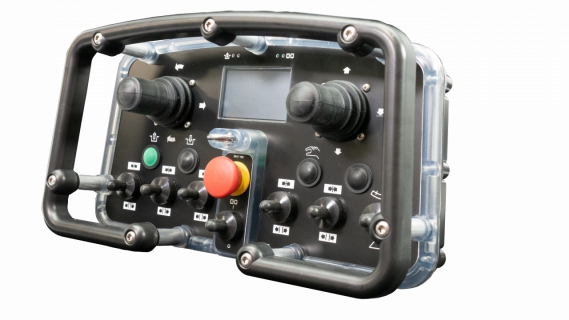The LXL Series Transmitter features 36 digital channels, and 16 analog functions. Configurable in either 900 MHz or 2.4 GHz with internal processing capabilities, this Transmitter offers a wide range of possibilities when it comes to applications.
Contact us today for pricing and availability.
Download the Spec Sheet.
Quick Specs
- Up to 52 functions
- Frequency Range: ISM 902 – 928 MHz; 2400 – 2483.5MHz
- Ingress Protection: IP67
- Sun Readable Display Provides Operator Feedback for System Status/Faults
- Battery Life: 15 h typical;Usage Dependent
- Operating Temp: –40°– 85 °C (–40°–176°F)
- Weight: 4 LBS.
| Receiver Options |
| LXR Receiver |
CAN Communication Only |
| LXM Receiver |
12 High Side Outputs, 6 Low Side Outputs, J1939 Communication |
| LXG Receiver |
CAN Communication Only |
| General Specifications (900 MHz) |
|---|
| Frequency Range | ISM 902MHz–928MHz |
| Frequency Control | 7 Frequency hopping channels ( Software Selectable ) |
| Modulation | DSSS ( Direct Sequence Spread Spectrum) |
| Error Correction | Automatic Error Detection and Automatic Retransmission |
| Operating Temperature | -40°C to 85°C (-40°F to 185°F) |
| Humidity | Up to 90% RH, non-condensing |
| General Specifications ( 2.4GHz ) |
|---|
| Frequency Range | 2400–2483.5 MHz |
| Frequency Control | 42 Frequency hopping channels ( Software Selectable ) |
| Modulation | MSK |
| Security | Channelization, System ID, and Vendor ID |
| Operating Temperature | -40°C to 85°C (-40°F to 185°F) |
| Humidity | Up to 90% RH, non-condensing |
| Transmitter Specifications |
|---|
| Display | 320 x 240 Sunlight-Readable E-Ink |
| Battery Voltage | 7 NiMH Rechargeable Batteries (2000 mAH) |
| Supply Voltage | 15 VDC Min.; 32 VDC Max |
| Max. Current Consumption | less than 200 mA (RF Active) |
| Digital Inputs | 36 Available |
| Analog Inputs | 16 Available - 0-5 VDC (configurable as Digital Inputs) |
| LED Outputs | 4 (RF and Error) |
| CAN Connection | J1939 (2-wire) |
| Battery Life | 15 h typical: Usage dependent |
| Dimensions | Approx. 12″ x 6.75″ x 5.1″ |
| Weight | Approx. 2 Lbs. |
| Enclosure | IP67 |
** Operating range is based on the use of an internal antenna; an external antenna may increase the range significantly depending on the application

